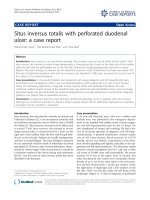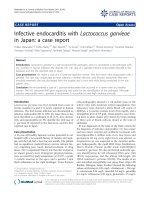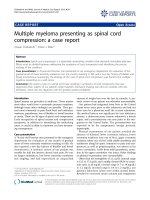Báo cáo y học: " Giant inframuscular lipoma disclosed 14 years after a blunt trauma: A case report" pptx
Bạn đang xem bản rút gọn của tài liệu. Xem và tải ngay bản đầy đủ của tài liệu tại đây (370.01 KB, 3 trang )
BioMed Central
Page 1 of 3
(page number not for citation purposes)
Journal of Medical Case Reports
Open Access
Case report
Giant inframuscular lipoma disclosed 14 years after a blunt trauma:
A case report
Giuseppe Nigri*, Mario Dente, Stefano Valabrega, Giacomo Beccaria,
Paolo Aurello, Francesco D'Angelo, Francesco Di Marzo and
Giovanni Ramacciato
Address: Department of Surgery, Sapienza University of Rome, 2nd School of Medicine, St. Andrea Hospital, Rome, Italy
Email: Giuseppe Nigri* - ; Mario Dente - ; Stefano Valabrega - ;
Giacomo Beccaria - ; Paolo Aurello - ; Francesco D'Angelo - ;
Francesco Di Marzo - ; Giovanni Ramacciato -
* Corresponding author
Abstract
Introduction: Lipoma is the most frequent benign tumor of the soft tissue. This lesion is often
asymptomatic except in cases of enormous masses compressing nervous-vascular structures.
Although the diagnosis is mostly clinical, imaging tools are useful to confirm the adipose nature of
the lesion and to define its anatomic border. Sometimes, lipomas may be the result of a previous
trauma, such as in this patient.
Case presentation: A 45-year-old man presented at our institution with a giant hard firm mass
in the upper external quadrant of the right buttock disclosed after a weight loss diet. Subsequent
magnetic resonance imaging showed a giant adipose mass developed beneath the large gluteal
muscle and among the fibers of the medium and small gluteal muscles. When questioned on his
medical history, the patient reported a blunt trauma of the lower back 14 years earlier. He
underwent surgery and histological examination confirmed a giant lipoma.
Conclusion: Lipomas might result from a previous trauma. It is hypothesized that the trigger
mechanism is activated by cytokine and growth factors released after the trauma. We herein
present an exceptional case of a giant post-traumatic lipoma which caused a painful compression
on the right sciatic nerve.
Introduction
Lipoma is the most frequent benign tumor of the soft tis-
sue. Although lipomas have been described in almost all
of the organs occurring in the central nervous system, gas-
trointestinal tract, muscles and joints, most of the time
they arise in subcutaneous tissue and can occur in every
part of the body. This lesion is often asymptomatic except
in cases of enormous masses compressing nervous-vascu-
lar structures. Although the diagnosis is mostly clinical,
imaging tools are useful to confirm the adipose nature of
the lesion and to define its anatomic border.
Sometimes, lipomas may be the result of a previous
trauma, such as in the present case. It is hypothesized that
the trigger mechanism for lipoma development is acti-
vated by cytokine and growth factors released after the
Published: 30 September 2008
Journal of Medical Case Reports 2008, 2:318 doi:10.1186/1752-1947-2-318
Received: 9 July 2008
Accepted: 30 September 2008
This article is available from: />© 2008 Nigri et al; licensee BioMed Central Ltd.
This is an Open Access article distributed under the terms of the Creative Commons Attribution License ( />),
which permits unrestricted use, distribution, and reproduction in any medium, provided the original work is properly cited.
Journal of Medical Case Reports 2008, 2:318 />Page 2 of 3
(page number not for citation purposes)
trauma [1]. We present a case of a giant lipoma discovered
14 years after the traumatic injury in a patient who pre-
sented with pain in the right leg.
Case presentation
A 45-year-old man presented at our institution with a
giant hard firm mass in the upper external quadrant of the
right buttock disclosed after a weight loss diet. His past
medical history was positive for a previous blunt trauma
in that area, as a result of a motor vehicle accident 14 years
earlier. Since that time, he had felt a mass arising very
slowly until the present time. The patient complained of
pain and a functional limitation of the right leg. For this
reason, he was scheduled for removal of the mass. Mag-
netic resonance imaging (MRI) was performed to assess
the anatomy of the mass and its relationship with the sur-
rounding structures (Figures 1 and 2). The mass was
located underneath the greater gluteus muscle and among
the fibers of the medial and lesser gluteus muscles. The
huge mass was excised with its capsule, once the gluteus
muscles were retracted apart. Its dimensions were 23 × 15
× 7 cm and its weight was 1.5 kg (Figure 3). The mass was
encapsulated, presenting fibrous septa. Histologic exami-
nation showed normal adipocytes with small nuclei
pushed to the periphery of the cell by a single lipid drop-
let. Two drains were left in place and removed on postop-
erative day 3 and 4, when the patient was finally
discharged.
Discussion
Lipoma represents the most frequent tumor of the soft tis-
sues with a predilection for female, obese patients, in the
5
th
to 7
th
decades. Although lipomas have been described
in almost all of the organs occurring in the central nervous
system, gastrointestinal tract, muscles and joints, most of
the time, they arise in subcutaneous tissue in every part of
the body. Histologically, there are sub-types of lipomas
that can be recognized by the presence of bone formations
(osteolipoma), an important myxoid change (myxol-
ipoma), rich fibrous tissue, or cartilage (chondrolipoma).
Even though there are different types of lipoma, their
gross appearance does not change. However, bony areas
or gray glistening formations can be found in osteolipoma
and chondrolipoma variants.
Magnetic resonance imaging showing the giant lipoma (*) underneath the right gluteus maximusFigure 1
Magnetic resonance imaging showing the giant
lipoma (*) underneath the right gluteus maximus.
Magnetic resonance imaging (coronal view) showing the lipoma and the head of the right femurFigure 2
Magnetic resonance imaging (coronal view) showing
the lipoma and the head of the right femur.
Surgical specimen (dimensions, 23 × 15 × 7 cm; weight, 1.5 kg)Figure 3
Surgical specimen (dimensions, 23 × 15 × 7 cm;
weight, 1.5 kg).
Publish with BioMed Central and every
scientist can read your work free of charge
"BioMed Central will be the most significant development for
disseminating the results of biomedical research in our lifetime."
Sir Paul Nurse, Cancer Research UK
Your research papers will be:
available free of charge to the entire biomedical community
peer reviewed and published immediately upon acceptance
cited in PubMed and archived on PubMed Central
yours — you keep the copyright
Submit your manuscript here:
/>BioMedcentral
Journal of Medical Case Reports 2008, 2:318 />Page 3 of 3
(page number not for citation purposes)
The typical clinical aspect is soft, floating, lobulated and
movable in the case of subcutaneous lipomas, with an
average size of 3 cm. Lipomas arising from deeper com-
partments, such as subfascial, intramuscular or intermus-
cular lipomas, appear as capsulated, well circumscribed
masses with smooth borders and often adherent to the
muscle. They represent less frequent lipomas that can
reach unusual size exceeding 10 cm, such as in this
patient.
The majority of lipomas retain a stable volume or slowly
increase in size, remaining painless and asymptomatic
masses that rarely invade the surrounding structures. Less
commonly, they reach giant volume and weight, espe-
cially in the case of post-traumatic lipomas, giving symp-
toms caused by nerve and vascular compression.
The reason for the uncontrolled growth is still unclear. In
the last few years, various theories have been put forward
such as endocrine, dysmetabolic, and genetic origin. Also,
acute blunt trauma has been considered one of the possi-
ble pathogenic causes [2,3]. A recent article examined 10
patients (12 lipomas) after blunt trauma. Neither compli-
cations nor recurrences have been reported after trauma.
Another article reported three cases of lipoma following
trauma [4]. These lipomas arose about 6 months after the
hematoma or bruise, and the treatment of choice was pre-
ventive drainage of the hematoma and compression of the
site. Several other reports described the typical patient
affected by lipoma as a woman who had had an acute
blunt trauma to the lower back area and thigh, rich fat tis-
sue areas in women.
The role of blunt trauma in lipoma development is prima-
rily supported by the rearrangement of the lipomatous tis-
sue after its transfascial herniation caused by a deep blunt
injury [5]. It has been proposed that the prolapse of nor-
mal adipose tissue outside its normal borders is a trigger
mechanism for lipoma development. Aust et al. reported
15 lipomas developed after blunt trauma [6]. It is hypoth-
esized that the trigger mechanism is activated by cytokine
and growth factors released after the trauma [6]. Signorini
et al. supported the active role of post-traumatic released
cytokine and growth factors on precursor adipose cells [7].
These factors, such as growth factor (GH) or insulin-like
growth factor (IGF) should be generated by degradation
products of the post-traumatic hematoma and act as a
stimulus. The same study correlated the level of partial
thromboplastin time (PTT) and the origin of lipomas. It
was observed that PTT was elevated in seven out of 19
patients, as already shown in the literature.
Conclusion
Lipoma represents the most frequent tumor of the soft tis-
sues. Several authors have reported cases of post-trau-
matic lipoma. The mechanism that causes these lesions is
not yet known. It seems to be related to the release of post-
traumatic cytokine and growth factors that stimulate pre-
cursor adipose cells. Knowledge of this process would be
helpful to inhibit post-traumatic lesions such as scars and
lipomas, however, further studies are necessary to achieve
this goal.
Competing interests
The authors declare that they have no competing interests.
Authors' contributions
GN designed the study, drafted and revised the manu-
script. MD, SV, GB, PA, FDA, and GR carried out the data
and image acquisition and participated in the writing
process. All authors read and approved the final manu-
script.
Consent
Written informed consent was obtained from the patient
for publication of this case report and any accompanying
images. A copy of the written consent is available for
review by the Editor-in-Chief of this journal.
Acknowledgements
The authors also wish to thank the nursing staff for their continuous sup-
port in data collection for scientific purposes.
References
1. Aust MC, Spies M, Kall S, Gohritz A, Boorboor P, Kolokythas P, Vogt
PM: Lipomas after blunt soft tissue trauma: are they real?
Analysis of 31 cases. Br J Dermatol 2007, 157(1):92-99.
2. Copcu E: Sport-induced lipoma. Int J Sports Med 2004,
25(3):182-185.
3. Copcu E, Sivrioglu NS: Posttraumatic lipoma: analysis of 10
cases and explanation of possible mechanisms. Dermatol Surg
2003, 29(3):215-220.
4. Penoff JH: Traumatic lipomas/pseudolipomas. J Trauma 1982,
22(1):63-65.
5. Brooke RI, MacGregor AJ: Traumatic pseudolipoma of the buc-
cal mucosa. Oral Surg Oral Med Oral Pathol 1969, 28(2):223-225.
6. Lemperle G: Posttraumatic lipoma. Plast Reconstr Surg 1998,
101(4):1159.
7. Signorini M, Campiglio GL: Posttraumatic lipomas: where do
they really come from? Plast Reconstr Surg 1998, 101(3):699-705.









